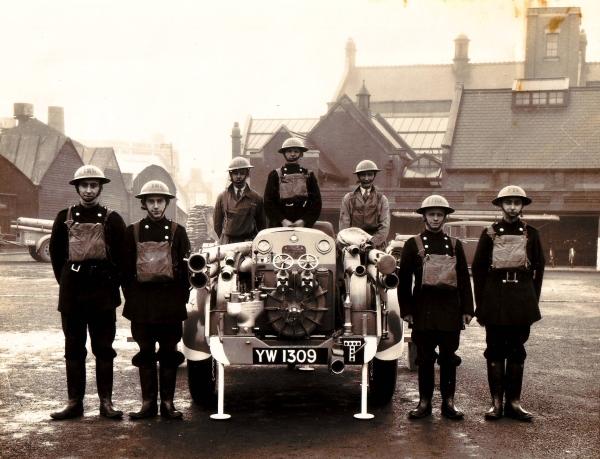

Blitz Story Archive, part 6
This is an archive of true stories about life in Coventry during the Blitz, as told by survivors and by the friends and families of victims. I would like to add as many Blitz memories as possible to this archive, in order to preserve history for future education, and to honour the memories of those who were killed by the bombing raids.
If you have any interesting memories or family stories of wartime Coventry or the Blitz please email them to met at and I shall be happy to add them to my site. Any wartime snapshots would also be much appreciated.
Blitz story from Mrs S Hope.
This picture is of the AFS (Auxiliary Fire Service) group at Paynes Lane Centre in 1939. My father Harold Ludlam, is the 3rd from the left (in brown overalls) as being a former apprenticed mechanic; he and the other man looked after the machines. The centre person was called Ginger and a particular friend of Dad, the man on the extreme left was Mr Garner. I understand that he owned a petrol station and garage on the Gulson Road, and it was to him that my father was apprenticed.

Auxiliary Fire Services (AFS) Group, Coventry
Being in a Reserved Occupation Dad wasn't called up unto, I think 1943, (his letters to Mum were dated from then but as Mum had them buried with her in her coffin, can't check) and didn't come out of the Royal Navy until late 1946. He served out of Sri Lanka, and twice in captured German boats. He was an Artificier (= ex apprentice) and ended up as Acting Chief Petty Officer.
What Dad told me about November 1940 was that initially the firemen thought they could put out the incendiaries by using sand - the water mains in the centre / Broadgate had gone early on. However the bombs came in at an angle and instead of going through down the roof to the floor, they went along between both layers of the roof - actual and false. They couldn't get at them and had no alternative but to let the roof burn. Although most of the Cathedral's treasures had been evacuated, apparently there were some things like crosses and bishop's staffs still in the building. Dad said that many people, not just firemen, rushed in to gather these together. When in the morning the extent of the damage became clear, he said people were just standing by the ruins crying - even grown men. To my parents the loss of the Cathedral was the biggest disaster of all and often talked about it to their contemporaries.
Apparently in the April 41 blitz, although obviously severe, some measures had been taken and the crypt of the church by St Mary's Hall and Hay Lane, was lined with lead(?) to hold water for pumping out.
My mother, Lilian Mary Beatrice Ludlam nee Harvey, worked for 35 years as their book-keeper for John Anslows (Furnishers) Ltd whose main premises were on the corner of Hay Lane and High Street. She was a clerk in the AFS (that's how she met Dad) but did fire watching duty on their roof. A land mine had gone off previously near her parent’s home in Stoke, damaging the back wall, so when not on duty, she was living with relatives in Kenilworth and thus not in Coventry on that night.
I don't know if you ever watched the series Goodnight Sweetheart where a modern day man time travels back to the days of WW2. In one episode he volunteers to do a fire watch with the local group and is absolutely petrified - the effects were excellent and Mum said that that was exactly how it was - you had to do your bit but were terrified all the time.
Quick navigation for Coventry Blitz stories
There are nine pages of stories:
Invasion: Alternative History of the German Invasion of England, July 1940
An interesting, well written fictional account by Kenneth Macksey of what might have happened if Germany had actually managed to launch their planned invasion of Britain during World War 2...
Landing at Dover and Hythe, then pushing on ground troops supported by the Luftwaffe as they push on to London.

